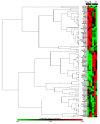Additive Effects of Zinc Chloride on the Suppression of Hepatitis A Virus Replication by Interferon in Human Hepatoma Huh7 Cells
- PMID: 33144437
- PMCID: PMC7811611
- DOI: 10.21873/invivo.12168
Additive Effects of Zinc Chloride on the Suppression of Hepatitis A Virus Replication by Interferon in Human Hepatoma Huh7 Cells
Abstract
Background/aim: Hepatitis A virus (HAV) infection is still one of the serious health problems worldwide, despite the existence of effective vaccines for HAV. Zinc compounds have antiviral activities against various DNA and RNA viruses. Therefore, we investigated the effects of zinc compounds on the antiviral activity of interferon against HAV.
Materials and methods: The effects of zinc compounds with or without interferon on HAV genotype IIIA HA11-1299 replication were examined in human hepatoma Huh7 cells. Cell viability was examined by the MTS assay. Inflammasome associated gene expression was examined by real-time reverse transcription-polymerase chain reaction.
Results: Both zinc sulfate and zinc chloride had an inhibitory effect on HAV replication. Zinc sulfate tended to enhance while zinc chloride significantly enhanced the anti-HAV effect induced by interferon-alpha-2a. Zinc chloride significantly up-regulated mitogen-activated protein kinase 12 (MAPK12) and down-regulated 6 related genes [baculoviral IAP repeat containing 3 (BIRC3), interleukin 1 beta (IL1B), proline-serine-threonine phosphatase interacting protein 1 (PSTPIP1), prostaglandin-endoperoxide synthase 2 (PTGS2), PYD and CARD domain containing (PYCARD), and tumor necrosis factor (TNF)].
Conclusion: Zinc chloride inhibits HAV replication and has additive effects on the anti-HAV activities of interferon.
Keywords: Antivirals; HAV; inflammasomes; interferon; zinc.
Copyright© 2020, International Institute of Anticancer Research (Dr. George J. Delinasios), All rights reserved.
Conflict of interest statement
No competing interests exist in relation to this study.
Figures





Similar articles
-
Knockdown of Mitogen-Activated Protein Kinase Kinase 3 Negatively Regulates Hepatitis A Virus Replication.Int J Mol Sci. 2021 Jul 10;22(14):7420. doi: 10.3390/ijms22147420. Int J Mol Sci. 2021. PMID: 34299039 Free PMC article.
-
Evaluation of Potential Anti-Hepatitis A Virus 3C Protease Inhibitors Using Molecular Docking.Int J Mol Sci. 2022 May 27;23(11):6044. doi: 10.3390/ijms23116044. Int J Mol Sci. 2022. PMID: 35682728 Free PMC article.
-
The JAK2 inhibitor AZD1480 inhibits hepatitis A virus replication in Huh7 cells.Biochem Biophys Res Commun. 2015 Mar 20;458(4):908-12. doi: 10.1016/j.bbrc.2015.02.058. Epub 2015 Feb 19. Biochem Biophys Res Commun. 2015. PMID: 25704089
-
Cell Culture Systems and Drug Targets for Hepatitis A Virus Infection.Viruses. 2020 May 12;12(5):533. doi: 10.3390/v12050533. Viruses. 2020. PMID: 32408660 Free PMC article. Review.
-
Molecular biology and inhibitors of hepatitis A virus.Med Res Rev. 2014 Sep;34(5):895-917. doi: 10.1002/med.21292. Epub 2013 May 30. Med Res Rev. 2014. PMID: 23722879 Free PMC article. Review.
Cited by
-
Hepatitis A: Epidemiology, High-Risk Groups, Prevention and Research on Antiviral Treatment.Viruses. 2021 Sep 22;13(10):1900. doi: 10.3390/v13101900. Viruses. 2021. PMID: 34696330 Free PMC article. Review.
-
Antiviral activity of zinc against hepatitis viruses: current status and future prospects.Front Microbiol. 2023 Oct 16;14:1218654. doi: 10.3389/fmicb.2023.1218654. eCollection 2023. Front Microbiol. 2023. PMID: 37908540 Free PMC article. Review.
-
Recent Advances in mRNA-Based Vaccines Against Several Hepatitis Viruses.Biol Proced Online. 2025 Jun 3;27(1):20. doi: 10.1186/s12575-025-00269-2. Biol Proced Online. 2025. PMID: 40461976 Free PMC article. Review.
-
Hepatitis A: Viral Structure, Classification, Life Cycle, Clinical Symptoms, Diagnosis Error, and Vaccination.Can J Infect Dis Med Microbiol. 2023 Jan 4;2023:4263309. doi: 10.1155/2023/4263309. eCollection 2023. Can J Infect Dis Med Microbiol. 2023. PMID: 36644336 Free PMC article. Review.
-
Treatment Options for Hepatitis A and E: A Non-Systematic Review.Viruses. 2023 Apr 28;15(5):1080. doi: 10.3390/v15051080. Viruses. 2023. PMID: 37243166 Free PMC article. Review.
References
-
- Gallian P, Barlet V, Mouna L, Gross S, Morel P, Le Cam S, Ricard C, Maugard C, Pouchol E, Flan B, Visse C, Djoudi R, Figoni J, De Valk H, Tiberghien P, Roque-Afonso AM. Persisting higher prevalence of hepatitis A virus RNA in blood donors, France, 2018. Euro Surveill. 2019;24(47):1900685. doi: 10.2807/1560-7917.ES.2019.24.47.1900695. - DOI - PMC - PubMed
-
- Koga M, Lim LA, Ogishi M, Satoh H, Kikuchi T, Adachi E, Sugiyama R, Kiyohara T, Suzuki R, Muramatsu M, Koibuchi T, Tsutsumi T, Yotsuyanagi H. Comparison of the clinical features of hepatitis A in people living with HIV between pandemics in 1999-2000 and 2017-2018 in the Metropolitan area of Japan. Jpn J Infect Dis. 2020;73(2):89–95. doi: 10.7883/yoken.JJID.2019.275. - DOI - PubMed
MeSH terms
Substances
LinkOut - more resources
Full Text Sources
Medical
Research Materials
Miscellaneous
